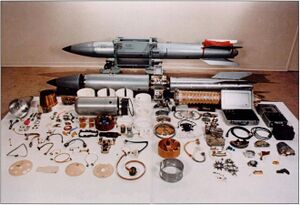Warhead
Topic: Engineering
 From HandWiki - Reading time: 3 min
From HandWiki - Reading time: 3 min
A warhead is the forward section of a device that contains the explosive agent or toxic (biological, chemical, or nuclear) material that is delivered by a missile, rocket, torpedo, or bomb.
Classification
Types of warheads include:
- Explosive: An explosive charge is used to disintegrate the target, and damage surrounding areas with a blast wave.
- Conventional: Chemicals such as gunpowder and high explosives store significant energy within their molecular bonds. This energy can be released quickly by a trigger, such as an electric spark. Thermobaric weapons enhance the blast effect by utilizing the surrounding atmosphere in their explosive reactions.
- Blast: A strong shock wave is provided by the detonation of the explosive.
- Fragmentation: Metal fragments are projected at high velocity to cause damage or injury.
- Continuous rod: Metal bars welded on their ends form a compact cylinder of interconnected rods, which is violently expanded into a contiguous zig-zag-shaped ring by an explosive detonation. The rapidly expanding ring produces a planar cutting effect that is devastating against military aircraft, which may be designed to be resistant to shrapnel.
- Shaped charge: The effect of the explosive charge is focused onto a specially shaped metal liner to project a hypervelocity jet of metal, to perforate heavy armour.
- Explosively formed penetrator: Instead of turning a thin metal liner into a focused jet, the detonation wave is directed against a concave metal plate at the front of the warhead, propelling it at high velocity while simultaneously deforming it into a projectile.
- Nuclear: A runaway nuclear fission (fission bomb) or nuclear fusion (Thermonuclear weapon) reaction causes immense energy release.
- Conventional: Chemicals such as gunpowder and high explosives store significant energy within their molecular bonds. This energy can be released quickly by a trigger, such as an electric spark. Thermobaric weapons enhance the blast effect by utilizing the surrounding atmosphere in their explosive reactions.
- Chemical: A toxic chemical, such as poison gas or nerve gas, is dispersed, which is designed to injure or kill human beings.
- Biological: An infectious agent, such as anthrax spores, is dispersed, which is designed to sicken or kill humans.
Often, a biological or chemical warhead will use an explosive charge for rapid dispersal.
Detonators
Explosive warheads contain detonators to trigger the explosion.
Types of detonators include:
| Type | Definition |
|---|---|
| Contact | When the warhead makes physical contact with the target, the explosive is detonated. Sometimes combined with a delay, to detonate a specific amount of time after contact. |
| Proximity | Using radar, sonar, a magnetic sensor, or a laser, the warhead is detonated when the target is within a specified distance. It is often coupled with directional explosion control system that ensures that the explosion sends the fragmentation primarily towards the target that triggered it. |
| Timed | Warhead is detonated after a specific amount of time. |
| Altitude | Warhead is detonated once it falls to a specified altitude, usually in an air burst. |
| Remote | Remotely detonated via signal from operator. (Not normally used for warheads except for self-destruction) |
| Combined | Any combination of the above. |
See also
References
- "The B61 (Mk-61) Bomb". 9 January 2007. http://nuclearweaponarchive.org/Usa/Weapons/B61.html.
- "B61". April 16, 2017. http://www.globalsecurity.org/wmd/systems/b61.htm.
- "B61 Nuclear Gravity Bomb". http://www.brookings.edu/projects/archive/nucweapons/b61.aspx.
- Stephen I. Schwartz. "Atomic Audit - The Costs and Consequences of U.S. Nuclear Weapons Since 1940". Brookings Institution Press, 1998.
- "B61 Thermonuclear Bomb". 2008. http://www.hill.af.mil/library/factsheets/factsheet.asp?id=5707.
- "NNSA Achieves Significant Milestone for B61 Bomb". June 30, 2006. http://nnsa.energy.gov/news/1032.htm.
- Chuck Hansen, U.S. Nuclear Weapons: The Secret History, (New York: Orion Books, 1988), pp. 162–164.
 |
Licensed under CC BY-SA 3.0 | Source: https://handwiki.org/wiki/Engineering:Warhead4 views | Status: cached on September 21 2024 00:07:01↧ Download this article as ZWI file
 KSF
KSF
